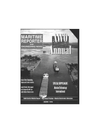
Page 10: of Maritime Reporter Magazine (March 1996)
Read this page in Pdf, Flash or Html5 edition of March 1996 Maritime Reporter Magazine
BULK CARRIERS:
A. Volatile Market
A Capesize bulk carrier for France, under construction at Gdynia.
As world trade continues to grow and the bulk shipping surplus in most sectors falls more closely into balance, the com- ponents necessary for profitable shipping should definitely be in evidence. As the new year begins, it is timely to reflect on some of the contrasts of the last 12 months to see if the portents for the future are positive.
On the dry bulk side, there is great concern about the orderbook, which is currently running at just under 25 percent of the existing fleet. Capesize owners saw earn- ings surge from an average of about $17,000/day in 1994 to more than $20,000/day in 1995. By the end of the year however, earnings had fallen flat, with rates dipping below $13,000/day.
However, volatility in rates is generally thought to reflect an approximate balance between sup- ply and demand, where small changes in either exerts consider- able influence on price. It would seem, therefore, that the bulk ship- ping markets are now finely bal- anced.
South Korea leads the way with bulk carrier newbuildings, with all five large yards involved. As of the end of 1995, Daewoo had orders for 26 ships, with Halla (18), Hanjin (17), Hyundai (30) and Samsung (19) rounding out the market.
The seven large shipbuilding companies in Japan are not far behind in orderbook numbers, with
Hitachi (12), IHI (11), Kawasaki (6), Mitsubishi (4), Mitsui (9), NKK (14) and Sumitomo (7), vigorously competing for market share.
Prices in the Far East have remained somewhat static over recent months, with the exception of Capesize vessels, which at a price of approximately $45 million, are down compared with a price of more than $50 million paid just two years ago. A good indication of
Panamax prices was exhibited recently when Brazil's Docenave paid Korea's Hyundai Heavy
Industries $28.7 million apiece for two 70,000-dwt units.
For smaller sizes (approximately 40,000-dwt units), German owners recently paid $23 million each for two ships at Guangzhou in main- land China, while Hamburg-Sud paid $25 million each for two 44,000-dwt units from Brazil's
Ishibras-Verolme. Parakou Ship- ping paid approximately $29 mil- lion each for two Panamax (73,000- dwt) units.
IACS Focuses On Safety
In a move to improve safety of bulk carriers, the International
Association of Classification
Societies (IACS) implemented sig- nificant advances in the safety regime of standard, single-side skin bulk carriers. The new requirements result from a major study into bulk carrier safety by
IACS, which has led the industry with successive measures for a safer fleet.
Encouraged by fewer bulk carrier casualties during 1995, IACS now wants to see improved survivabili- ty for the condition most associated with bulk carrier loss — hold flood- ing while carrying heavy, high den- sity cargo. IACS is proposing high- er design in new ships and greater attention to preserving watertight integrity in the existing fleet.
For new bulk carriers 492 ft. (150 m) long and larger, new IACS
Unified Requirements cover the longitudinal strength in a hold flooded condition and the strength of watertight corrugated trans- verse bulkheads. In addition, other Unified Requirements will address the strength of the double bottom structure when a hold is flooded. These requirements will apply to bulk carriers loading not only high density cargoes such as iron ore, but also to any other solid cargo of a bulk density one ton per square meter or more. These new requirements will apply to new- buildings contracted after July 1, 1997.
Also, an urgent review is being carried out of member societies' existing requirements for side shell frames, and also on load strength criteria for hatch covers in order to assess their integrity under extreme loads. This review may identify a need to develop appro- priate Unified Requirements. For existing ships, IACS members decided to bring forward that ele- ment of the enhanced special sur- vey covering all cargo holds of sin- gle side skin bulk carriers, 10 years of age and above, of 492 ft. (150 m) and above, which have not been subject to the five-year enhanced special survey. The date of applica- tion was to be announced in
February, when the details were scheduled to be worked out. The accelerated surveys will have to be completed within 12 months. All bulk carriers should, therefore, have been through the cargo hold element of the five year, enhanced special survey, probably before the end of 1997 — an advance of about 18 months.
This program will build on the advances made through the intro- duction of the enhanced survey program (ESP) in 1993. However,
IACS considers that it is important that the experience of ESP should be learned and, having sought owners' opinions in 1995, is also reviewing the extent and scope of the annual and intermediate (two/12 years) surveys to establish whether any further enhance- ments are necessary.
To aid those involved with the survey, inspection and operation of bulk carriers, IACS, building on
The Capesize bulk carrier World Action was built by Korea's Daewoo. 12
Maritime Reporter & Engineering News

 9
9

 11
11
